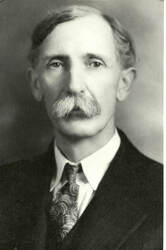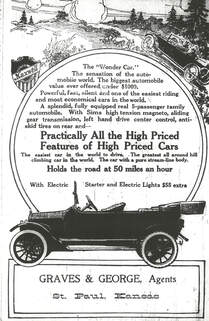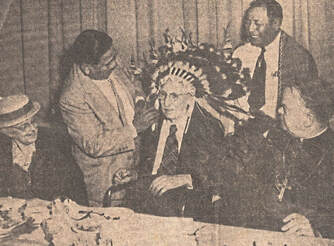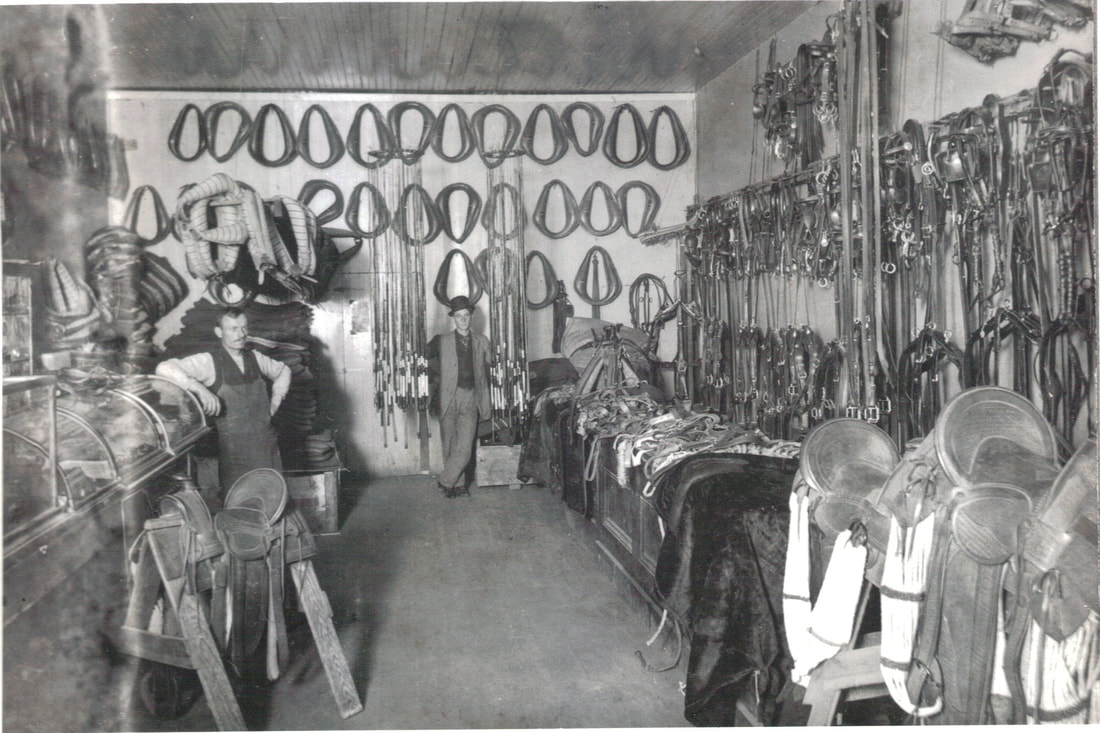 William Whites Graves William Whites Graves If W. W. Graves had chosen to be a journalist, a historian, a writer, a printer and publisher, a national law enforcement official, or a businessman he would have probably done well with any of these careers. But he chose to do it all and wrapped it up with the skills of an accomplished entrepreneur and businessman. William Whites Graves was, in fact, a model of the early post-frontier entrepreneur. He was smart and ambitious. He received a business education at the St. Francis Institution here in Osage Mission. Perhaps, more than anything he had learned to recognize, and sort out opportunities and grab those that would benefit him or even others. One of his early opportunities occurred in 1895, when B.B Fitzsimmons and his father, staked him in acquiring the Neosho County Journal (Later, the St. Paul Journal). In 1902, Fitzsimmons and some other Neosho County men sponsored Graves in a competition to publish the Anti Horse-Thief Association Weekly, which was a national newspaper. He submitted a successful bid, and the resulting contract provided the capital Graves needed to build a dynamic, fast-growing publishing business. In just a few years he moved into a larger building, acquired one of the first Linotype type-setting machines in the region, installed his own gasoline-powered electrical generation plant, and hired and trained people to run this printing business while he pursued other opportunities. Not only did Graves publish the A.H.T.A. Weekly newspaper, but he also took an active role in the organization’s reformation and growth. During the 1920’s he served as the organization’s national vice president and president. [1] Graves’ experience with the Fitzsimmons' and other supporters might have ingrained a sense of gratitude that he passed on. When German-born harness maker, Jo Sork, arrived at St. Paul in 1908, Graves invested in Sork’s acquisition of the Null harness shop, even though Graves had no background in harness making. Nevertheless, the Sork-Graves partnership in the Sork Harness Shop prospered until Sork’s retirement in 1935.  A Graves - George Maxwell "Wonder Car" Advertisement. A Graves - George Maxwell "Wonder Car" Advertisement. In 1915 W.W. Graves teamed with Ed George in selling the Maxwell Touring Car, also touted as “The Wonder Car!” At the time, the Maxwell was known for having innovative suspension and drive-train features that enabled it to hold the road better than any competitor; and given the condition of roads in those days that was a pretty big deal. Graves was no stranger to innovation. His previously-mentioned gasoline electrical generator was later replaced with a safer steam generation system. Private electrical generating systems allowed him, and his brother-in-law A.J. Hopkins, to open and operate three movie theaters — one outdoor and two indoor — several years before the electrical power grid arrived in St. Paul. While W.W. kept several business interests going, his mainstay was insurance. As early as 1900, he purchased the local insurance company of J.J. Thompson, representing the American Central, Hanover, Phoenix, and Springfield Insurance Company. In 1932 he partnered with Frank A. Munding in purchasing the insurance business of M.J. Kelley. In this business, they represented sixteen of the largest insurance companies in America. In 1946, he teamed with nephew Fielding S. “Hoppy” Hopkins in the Graves-Hopkins Insurance Agency with continued past Graves’ death and until Hoppy’s death in 1969. Graves and his wife Emma were devoted Catholics who supported their church. In 1932 they donated an entire public address system to St. Francis Catholic Church. Many of the church pamphlets, recitation books, and other materials were printed and donated. Graves was a charter member of Knights of Columbus Council 760 and was undoubtedly instrumental in their role of having Father Paul Mary Ponziglione's portrait painted and donated to the Kansas State Historical Society in 1906. [2] But one force drove Graves harder than his varied business interests. He was a passionate historian who loved to write. He also understood the role the Osages, the French fur traders, and the Catholic Church played in the settlement of Kansas. Moreover, the writer and historian owned his own publishing company. During the period of about 1916 and 1951, he published more than 15 books and publications, most of them dealing with the early history of southern Kansas. In his later days, Graves made building a public library in St. Paul one of his last priorities. Knowing his days were numbered, he turned his personal collection of books over to the local Women’s Home Demonstration Units and challenged them to make it happen. He knew he had chosen a formidable project management team and they did not fail.  Parson Sun Photo of June 2, 1952, Showing the Presentation of an Honorary Osage Tribe Membership to Mr. Graves at his recognition banquet on May 31, 1952. Suzie Graves is at far left. Bishop Mark K. Carroll at far right. Parson Sun Photo of June 2, 1952, Showing the Presentation of an Honorary Osage Tribe Membership to Mr. Graves at his recognition banquet on May 31, 1952. Suzie Graves is at far left. Bishop Mark K. Carroll at far right. On the evening of May 31, 1952, a group of distinguished guests gathered in the gymnasium of St. Francis School. The banquet was sponsored by the 3rd District Kansas Press Association. About 240 people attended. It is hard to imagine that a banquet, in St. Paul Kansas, could be attended by the diversity of interest groups that were there. The group included a bishop, an Indian chief, farmers, businessmen, state officials, college presidents, Press Association executives, the president of the Kansas State Historical Society, pressmen from across southeast Kansas, and Graves’ friends from St. Paul. W. W.’s wife, Susie Gibbons Graves sat at his right side and was beaming with pride in most of the press photos that were taken that evening. Among the accolades bestowed on William Whites Graves that evening, two stood out. Bishop Mark Carroll, of the Diocese of Wichita, presented a Vatican Knighthood of St. Gregory on behalf of Pope Pius XII. He was also made an honorary member of the Osage Tribe, which made it possible for the Osages to declare him an honorary chief of their tribe — a very rare honor. Weeks later, on July 22, 1952, W.W. Graves collapsed and died of a heart attack in his home at St. Paul. It was less than two months since the banquet. It was then that the Eastern Kansas community realized they had almost missed a chance to recognize a life lived well. Some Reference Information:
1. For more information about W.W. Graves, and the Southeast Kansas, Neosho County, community involvement in the A.H.T.A., follow THIS link. The link should open in a separate window or tab. 2. For more information about Father Paul Ponziglione and the KofC portrait, follow THIS link. Comments are closed.
|
Thoughts 'n ThingsSome 'Thoughts' and short articles about past and present-day St. Paul and the Southern Kansas - 4 State Region. Archives
December 2023
Categories
All
|
- Home
-
Our Story
- 1. The Stage is Set
- 2. The Osages Enter Kansas.
- 3. Earliest Commerce
- 4. Earliest Protestant Missions
- 5. The Catholic Osage Mission >
- 6. Progress and Tragedy
- 7. The Missionary Trails >
- 8. A Dangerous Balance - The Civil War >
- 9. The Osage Leave Kansas >
- 10. A Very Unique Community is Born >
- 11. Regional Boarding Schools >
- 12. Transitions
- 13. The Passionists Era Begins
- 14. Citizen Lawmen - The A.H.T.A. >
- 15. The Passionist Influence is Expanded
- 16. The Schools Today >
-
Characters
- The Osages
-
The Missionaries
>
- Father John Schoenmakers >
- Fr. John Bax >
- Mother Bridget Hayden
-
Fr. Paul Ponziglione
>
-
Father Paul's Memoir
>
-
Index - Father Paul's Memoir
>
- Dedication & Introduction
- IX. Construction & Acceptance of Mission Buildings.
- X. Fr. Schoenmakers Arrives at Osage Mission
- XI. Miss Lucille St. Pierre Came to the Neosho
- XII. Progress of the Schools
- XIII. Origin and Development of the Roman Catholic Church in Kansas
- XXVII - Winds of War
- XXVIII — Fr. Schoenmakers Return
- Chapter XLII - Farming Issues, Death Of Father Colleton
- Chapter XLIX - Includes The Death of Fr. Schoenmakers
- Chapter L — Dedication of the New Church
- Conclusion
- Appendix I — Copy of a letter to Sister M. Coaina Mongrain about the coming of the Sisters of Loretto at Osage Mission
- Appendix 6 — A Sketch of my Biography
- Appendix 7 - Letter to W. W. Graves
-
Index - Father Paul's Memoir
>
-
Father Paul's Memoir
>
- Father Philip Colleton
- Brother John Sheehan
- W. W. Graves
- 17 Sisters
- 17 Sisters II - Fr. Fox's Sermon
-
Who's Behind the Window
>
- Who We Were 120 Years Ago
- 1. The Thomas Carroll Window
- 2. The W.W. O'Bryan Window
- 3. The Jas. Owens & Family Window
- 4. The C.P & C.J. Hentzen Windows
- 5. The Dr. McNamara & Family Window
- 6. The Fitzsimmons & Family Window
- 7. The Parents of T.K. Joyce Window
- 8. J.E. Sevart & Family Window
- 9. The Rev. John Schoenmakers S.J. Window
- 10. The Patrick Diskin and L&M George Window
- 11. The J.A. Johnston & Family Window
- 12. The Peter & Jacob Bonifas Windows
- 13. The Mr & Mrs. Patrick Keeting Window
- 14. The John Butler Window
- 15. The Mr. & Mrs. Gutting Window
- 16. Rosette Window Above Doors
- 17. The Michael A. Barnes Window
- 18. The Henry M. O'Bryan Window
- 19. The John and Bridget McCarthy Window
- The Sodality Windows
- The Church Women's Bonfire (Graves)
- Beechwood
- John and Margaret Naudier
- Fr. Tom McKernan - The Poet Priest of Kansas
- The Dimond Family and Estate Sale
- Dear Sister >
- A Year and a Day — Passionist Memories.
- Mary Elizabeth Lease
- K of C Council 760 - The Early Days
- Our Hometown Boys
- SPHS Class of 1956
-
Places
- The Great American Desert
- St. Francis Catholic Church
- St. Francis de Heironymo Catholic Church Grounds
- St. Paul - 135 Years Ago
- St. Paul - 1890's as a Scale Model.
- St. Paul - The Booming 60's
- Osage Mission as a Statewide History Finalist
- St. Francis Cemetery
- Hope Cemetery
- The Basement Chapel
- World War I Museum Display
- St. Paul Middle School >
- Ladore
- St. Boniface, Scipio KS
- Road Trip - Father Emil Kapaun
- Exchange State Bank Robbery!
- Thoughts ...
- Links
- Link Page
Thoughts 'n Things
Past and Present Day St. Paul, Southern Kansas and The Four - State Region.

|
acatholicmission.org is a privately hosted website. We hope that our site will educate and entertain those who are interested in the fascinating Osage Mission - St. Paul - Neosho County Kansas story. Ours is a regional story that crosses state lines, ethnic groups, faiths and a variety of frontier and post-frontier interests. Enjoy.
acatholicmission.org Copyright © 2016 - 2024. All rights reserved. (See copyright note on Contact page.) |

 RSS Feed
RSS Feed